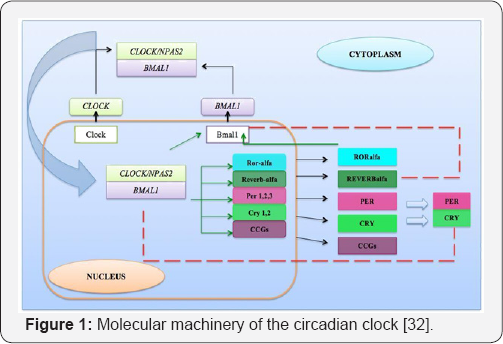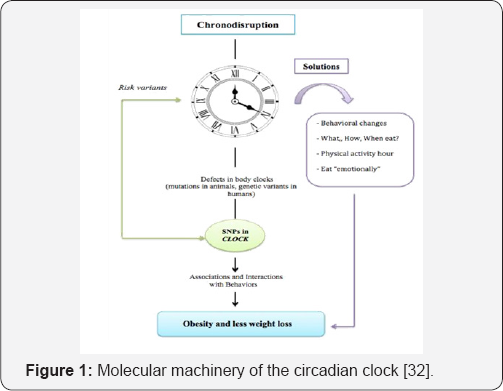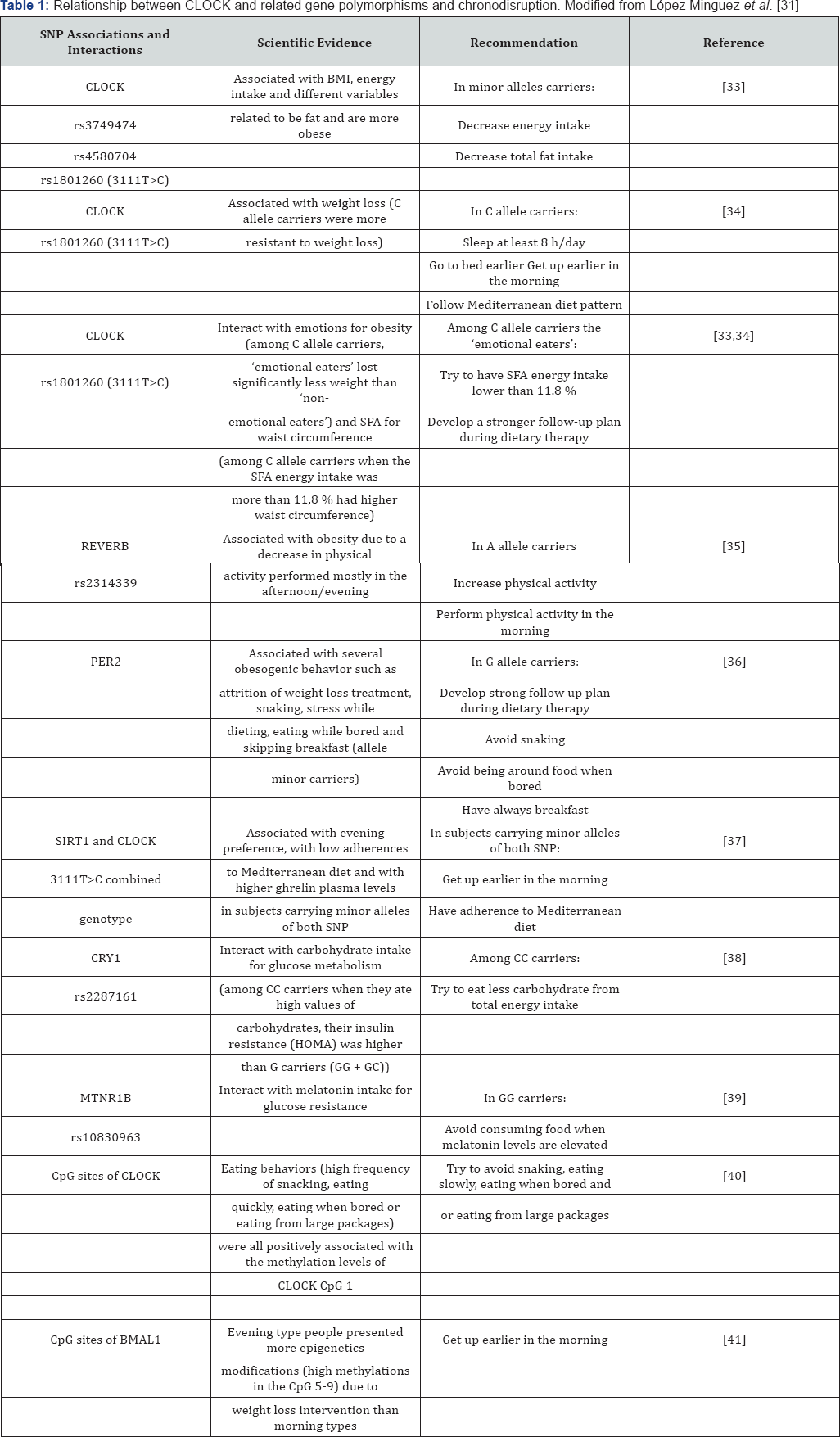Clock Genes, Chronodisruption, Nutrition and Obesity_Juniper Publishers
Authored by Francisco J Sánchez Muniz
Abstract
The existence of biological clocks has been
demonstrated in all living beings. Such clocks control the
physio-metabolic activities of cells, organs and systems to warrantee
efficacy in the process to obtain energy and metabolize nutrients under a
homeostatic point of view. These ordered activities are known as
circadian rhythms, occurring approximately every 24h, and depend on the
activity of groups of neurons (oscillators) negatively interrelated. The
oscillatory activity is related to gene expressions that implicate
rhythms in the mRNA and protein production. However, alterations in such
synchronism is frequently found because of many of human activities are
performed in "unexpected” environmental conditions. Thus, light
intensity and environmental temperature are normally rather constant; in
addition light/darkness cycles are modified by working/leisure times,
travels, meals and activities braking the ticking of the biological
clocks producing chronodisruption. The aim of this mini review is to
give some central information on most common chronodisruption aspects
and their relationships with dietary habits and obesity. After a short
and concise introduction explaining central aspects of biology clocks
and disruptors, the role of some prevalent dietary behaviors (e.g.
frequent snaking, late meals and large food consumption) acting at the
levels of CLOCK genes are described and discussed. This mini review far
from to be exhaustive pretends to open discussion on the most accepted
information, ending suggesting some future research to understand the
role and importance of CLOCK genes in obesity.
Abbreviations: CD: Chronodisruption; Cry: Cryptochrome; CCGs: Clock Controlled Genes; PER: Clock Genes Perio; SCN: Suprachiasmatic Nucleus
Introduction
Most living organisms have developed since millennium
mechanisms to improve response to daily or annually environmental
changes. Thus, physiometabolic changes induced by light/dark,
low/warm/high temperatures, could be more predictable during the
season/day time, and consequently metabolic processes could be prepared
in advance (e.g. migrations, reproduction, breeding) to improve their
efficacy. The circadian system (from Latin circa that means
approximately and diem meaning one day) has the aptitude to organize the
internal temporal order of physiological processes according to
predictable environmental cyclic signals. The circadian system is
organized in a similar manner to a clock that ticking controls
activities to optimize energy and nutrient utilization. It is accepted
the existence of clocks in the different organs and systems of mammals
controlling their activities that, in turn, are controlled by a master
clock [1].
The central clock is located in the suprachiasmatic nucleus (SCN) of
the hypothalamus where two groups of various neurons (ca., 20,000
each)-the ventrolateral and the dorsomedial areas-are negatively
interrelated. The light/ dark information analyzed in the retina arrives
the SCN via the retino hypothalamic tract, inducing at a cellular level
changes in the gene expression ofthose antagonic neuronal groups [1].
Thus, it can be accepted that circadiam system and, thus, rhythmicity
is controlled by oscillatory -positive/negative-mechanisms that at
cellular levels implicate daily control of the mRNA and proteins.
Although each neuron is able to act as an independent oscillator within a
cell-autonomous period, each neuronal group acts as an oscillator that
is synchronized to produce a circa 24h common periodicity [2,3]. GABAergic interneurons are responsible to inhibit one oscillator when the antagonic one is active and vice versa [4].
Thus, the ventrolateral area is the responsible for light
synchronisation, while output regulation is mediated by dorsomedial area
[5,6].
The BMAL1 and CLOCK transcription factors constitute a heterodimer,
which activates the expression of the clock genes Perio (PER),
Cryptochromes (CRY), REVERB, and ROR, as well as other clock controlled
genes (CCGs) by binding to E-box augmentation elements [7].
PER and CRY dimerize and inhibit their own expression by translocation
into the nucleus and also acting as repressor of the CLOCK/BMAL1
heterodimer with a delay of several hours [8].
A second loop also regulated by CLOCK: BMAL1 heterodimers activates the
transcription of Rev-erb and Ror genes. Latter, REV-ERB and ROR
transcription factors compete to bind response elements present on the
Bmall promoter [1]. Thus, REV-ERB proteins repress Bmall transcription [9], while ROR proteins activate it [10] (Figure 1). In addition it has been described that ROR proteins are implicated in rhythmic Bmal1 expression [11]
and that PER is lysed by the proteasome regulating the oscillatory
loops. As the cellular processes implicated in the fine control of the
master clock, and in turn, in that of the different organ and tissue
clocks is out from the aim of this mini review we will not insist more
in these molecular aspects, although the reading of recent published
reviews in chronicity is highly recommended.

Circadian system
In humans the circadian system is formed by a
structural frame, ordered in a hierarchical manner, which is responsible
for generating this rhythm and its synchronization with the
environment. It consists of three main elements: circadian clocks,
imputs tracks and outputs tracks [12].
Circadian clocks: As previously commented the
central clock is located in the SCN of the hypothalamus. Its existence
has been known since 1972, "resetting" daily by signals of
light/darkness that come from the retina, through the optical pathways.
Changes in the light/dark relationship are the main input to the SCN but
there are other information produced by the interaction of the living
being with the surrounding environment, such as propioceptive,
thermoactive, acoustic signals that reach the SCN or its connections
with other brain areas contributing to the adjustment of this central
clock. In addition, the schedule of meals and exercise seem to influence
mainly the activity of other clocks located in different organs of the
body. Thus, since 2001, it is known that the alarm central harmonizes
the action of peripheral clocks located in organs and tissues such as
lung, heart, liver, pancreas, kidney and adipose tissue, among others,
through the activity of the vegetative nervous system and the secretion
of hormones [12,13].
In addition the SCN has important connections with the adenohypophysis
and pineal gland participating among other functions in the cortisol and
melatonin production controls [13].
Inputs tracks: Our existence and behavior
clearly depend on the signals from the environment and from or body
organs. These signals have central importance in the circadian rhythms
as the "Clock" must be adjusted periodically through the synchronizers
or zeitgebers (in German, "giver") which fluctuate rhythmically and
integrate together these tracks [13].
Output tracks: The master "Clock" temporary
transmit signals to the rest of the effectors by sending information to
those brain areas involved in the regulation of body temperature,
patterns of behavior and sleep-wake cycle, to neuroendocrine axes and
peripheral organs. The SCN controls humoral mediators (e.g. melatonin
and cortisol), sends nerve projections and physical signs such as the
pace of body temperature. From all mediators, the best known is the
melatonin hormone, which is involved in the regulation of sleep and
circadian rhythmicity, its synthesis subjects to the SCN activity, the
inhibitory action of light, with minimum and maximum levels at day and
night, respectively [13].
With regard to the timing light, the pineal gland is responsible for
regulating the sensitivity on the part of the SCN to various signals
responsible for encoding the lighting of the environment [14].
That means, the lack of light would reduce the inputs to the system by
inducing a lower production of melatonin, which in turn is an sleep
inducer, through implementing circuit inhibitors modulated by genes.
Unlike, the presence of light energy would reduce the production of
melatonin, which would delay or inhibit the induction of neurons
involved in the initiation and maintenance of sleep. Therefore,
melatonin, mainly produced by the pineal, makes the different circadian
oscillators located in the SCN act similarly to the object to operate as
a circadian clock [14].
Chronodisruption
The alteration on the rhythmicity in any of the
central or peripheral oscillators, the unstable wrong phase relationship
between them, the uncoupling between inputs, pacemarkers and outpouts
induces chronodisruption. Chronodisruption (CD) is every day more
prevalent and favored by environmental factors that in turn are
conditioned by the present living styles. Thus, working in rooms
illuminated by artificial light, the almost permanent exposition to
bright light at night (working with machines, computers, tablets) or dim
lights during daytime, chronic and/or social jet-lag and shift-work can
induce circadian system disruption [15].
However, other input alterations may also result in CD. Thus, warm and
stable temperatures, irregular sleep time, low physical activity and
frequent meals or constant snacking work as disruptors [16,17].
Ageing is a source of CD since it affects the circadian system and in
some way can be related with the modification of some biomarkers
involved in obesity. Three main factors are implicated in the frequent
CD observed in aged people: a) decreasing inputs (e.g. reducing light
reception and blue light transmission) [18],
and those other receptor signals (e.g. noice, odors); b) necrosis and/
or apoptosis and loss of functionality of oscillators and their
antagonists in the central clock [19,20] as well as of pineal and adenohypophysis neuroendocrine cells [21-23]; c) the reduction of day-night contrast due to losses in the rhythm amplitude [24,25].
Chronodisruption, obesity and metabolic syndrome
CD is associated to a predisposition to obesity,
metabolic syndrome, cardiovascular diseases, cognitive and affective
impairments, sleep disorders, premature ageing, prostatic, mammary and
colorectal cancer and, in general, higher mortality [1,26,27].
This mini review will mainly focus on obesity, given the existing
scientific evidence between obesity and CD, which contributes to
negatively affect many functions involved in the metabolic regulation of
lipids and carbohydrates as well as in the response to insulin [28].
Obesity is a chronic disease of multifactorial origin
in which multiple factors of genetic, hormonal, metabolic, social and
cultural type influence and, in a coordinated and interactive way,
provoke an imbalance between energy income and expenditure, leading to a
fat mass and body weight gain. Obesity is characterized by an increase
and content of adipose tissue, which causes morphological and metabolic
alterations together with increase in several comorbidities [29].
Currently, a nearly unstoppable incidence and prevalence growth of
obesity has been reported, representing a very important public health
problem, and may lead to different degrees of insulin resistance,
steatosis, metabolic syndrome and increased cardiovascular morbidity and
mortality [12,29].
As already mentioned, a number of factors are involved in the etiology
of obesity. Normally, obesity is treated modifying eating behavior and
physical activity; however, in order to optimize results the impact and
interaction of life style with genes should be considered (Figure 2 & Table 1). In relation to the topic of this mini review, two major factor groups can be defined.


Endogenous factors: The Clock, Bmal1 and Per2
proteins play a very important role in this circadian functioning, so
some failure in their synthesis and / or structure or in their
associated CLOCK genes can induce CD. Polymorphisms of a single
nucleotide (SNPs) are very common in a specific position of the genome
and they are responsible, at less in part, of the inter individual
differences in the vulnerability to certain diseases [28].
Although information is growing up very quick we have selected some
SNPs in the CLOCK genes whose importance on obesity and metabolic
markers has been reported. (Table 1)
includes general information about a selection of the most important
gene polymorphisms implicated in the CD-obesity relationship.
Clock: SNPs rs3749474, rs4580704 and rs1801260
were associated with variables related to obesity, energy intake and
BMI; SNP rs1801260 with weight loss, sleeping less, poor adherence to
the Mediterranean diet. They carriers fit better within the evening
type, and interact with saturated fatty acid intake for waist
circumference and emotions. Also SNP rs4580704 interacted with
monounsaturated fatty acid intake
for blood glucose [31].
New evidences at epigenetic level of CpG sites of CLOCK gene suggest
association with erratic eating behaviors (eating quickly and/or hudge
amounts, snacking and eating when bored) [31].
Other genes: PER2 SNP rs2304672 was associated
with snacking, eating when bored, stress, etc; SIRT1 with CLOCK (3111
T>C combined genotype) were related to adherence to Mediterranean
diet; REVERB rs2314339 appeared associated with physical activity, and
CRY1 rs2287161 interacted with carbohydrate intake [31].
Epigenetic modifications at the level of CpG sites of BMAL1 have been
reported to be associated with weight loss intervention [31].
Exogenous factors: Both the physical activity
and the meal schedules, among others, act as relevant synchronizers.
Thus, it is clear that it is not only important what and how we eat but
when we do it. In this regard, it has been found that a regular meal
schedule contributes to the maintenance of the internal temporal order
of the circadian system [13].
In addition, the response to energy dietary restriction differs in some
individual with respect to others depending on the degree of CD.
Therefore, to this aim, it has been proposed an index that based in some
CD markers helps predicting weight loss [28].
Various determinations were made throughout the day, being the most
predictive variables body temperature, blood pressure and the secretion
of certain hormones such as melatonin and cortisol, since they present
more precise rhythms [28,30].
From these, the so-called CD index was calculated permitting to
classify patients with or without CD. Corbalan-Tutau et al. observed
that the weighted mean of the first four factors explained the 53.8% of
the total variance. These authors proposed the value 40.3 as CD index
cut-off point as the area of the COR (Operational Characteristic of the
Receiver) curve was 0.95, being 40.3 the optimal cut-off point as this
value corresponded to the point that shows the best sensitivity along
with the best specificity [30].
Therefore, individuals with moderate obesity who present a value for
the already commented CD index above 40.3 will have CD. By the way,
women with high CD score displayed higher BMI, waist perimeter, fasting
glucose, total cholesterol and triglyceride concentrations and also
higher systolic and diastolic blood pressure values; thus, were at risk
for metabolic syndrome [28]. In agreement with others [31]
and taking into account all already commented facts, some general
nutritional and lifestyle suggestions should be taken into consideration
in order to palliate the growing incidence and prevalence of obesity:
- Sleep during the night and be active during the day. Sleep in total darkness when possible.
- Avoid intense light exposition during night time.
- Make exercise during the morning.
- Avoid eating at night hours.
- Have adherence to Mediterranean diet
- Eat the main meal of the day before 15:00hrs.
Conclusion
Light/dark cycles are central in the control of the
circadian system and that of several metabolic and physiological aspects
in humans. However, environmental factors have drastically changed the
daily inputs arriving to the master clock favoring its disruption and
that of the other pacemarkers. Among them, eating and sleeping times,
light intensity exposition, noice, social jet-lag and shift works have
been considered crutial in the understanding of CD. Nonetheless, taking
into account the existence of interactions between way of living and
presence of some CLOCK polymorphisms, active research is demanded to
improve knowledge in such interaction. This effort should be performed
to find out mechanisms and interactions occurring at critical life
periods (fetal, lactation, childhood, aging) and also addressed in at
risk people (e.g. over weighted, with type 1 obesity and familial
antecedents) in order improve our knowledge and to decrease the growing
tendency of both obesity and CD.
To Know More About Current Research in Diabetes & Obesity
Journal Please click on:
https://juniperpublishers.com/crdoj/index.php
https://juniperpublishers.com/crdoj/index.php



Comments
Post a Comment